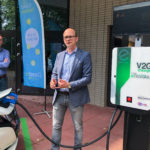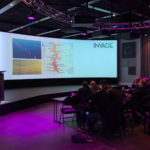The pilots have begun testing the INVADE integrated platform: “An excellent example of how we can bring flexibility and storage technology to the end-users”
By Mari Kristine Buckholm, Smart Innovation Norway 13. June 2019
In the end of May, the INVADE consortium was gathered in the Netherlands. During the two-day meeting, all five pilot owners presented their progress to the project partners.
“There is still some way to go, but it looks very promising and I am quite sure that the project will be a success,” says Dieter Hirdes, project manager of the EU Horizon 2020 project INVADE – after the consortium meeting in Arnhem, the Netherlands, has ended on Wednesday, May 29th.
The purpose of the meeting was to sum up the status of the pilot testing as of now and plan for the remaining six months of the project. The five pilots in Norway, Spain, Bulgaria, Germany and the Netherlands all test the INVADE platform solution in different ways at various sites.
“The pilots have demonstrated that they are using the INVADE platform in different ways for their local applications; from hotels to distribution grid storage to EV charging,” notes Hirdes. He adds:
“What is interesting is that we can use the same platform for new so-called exploitation pilots, which are commercial applications where we use the platform to provide an optimization service for local energy management systems or charging management system. We already have five such exploitation cases around Europe, and that is very encouraging.”
Engages the end-customer
Pilot owner Lyse in Norway demonstrates how big data, machine learning and analytics parts of the INVADE platform can be integrated into existing smart home solutions in Stavanger, with respect to vehicle-to-home (V2H), batteries and boilers.
“We send our data into the INVADE platform and get a controlled plan back on how the equipment should function for the next 24 hours. Eventually, this will give the end-customer benefits and help them save money,” explains Trond Thorbjørnsen, Senior Business developer at Lyse.
What is unique about the Lyse pilot, is that the focus is on the end-customer:
“We want to find out how we can engage the end-customer to be a part of the future energy business, and that is the magic of the project,” says Thorbjørnsen.
The flexibility operator’s role
Pilot owner Estabanell in Spain has installed a storage system, with the integrated INVADE platform and power electronics ad-hoc designed, in a secondary substation in the Estabanell network in Granollers, which supplies 158 users, of which 13 belong to the DSO services.
“At our site, we are testing the role of the flexibility operator providing flexibility services to the DSO and the BRP. What is different from the other pilots is that we are testing the interaction of these two actors in the electricity sector. It is interesting to see what happens when both of the actors ask for flexibility from the same source, a battery (210 kWH), installed at the substation,” says Vera Palma Costa at Estabanell.
Her colleague, Ramón Gallart, believes the INVADE project will have great impact on the European electricity sector, with its many different rules and regulations – and maybe even the world.
“It is an excellent example of how we can bring flexibility and storage technology to the end-users. We have already received questions from end-users regarding how they can install such a solution and which problems they can solve inside households and in the electrical network,” notes Gallart.
Good service + waste reduction
Pilot owner Albena in Bulgaria has installed a new photovoltaic (PV) system, protection and cables leading to the main transformer board. The battery storage system with suitable inverters, protection and battery management system is situated at the transformer substation site. A full energy monitoring system consisting of power meters and software produced by Schneider Electric is already functioning on site.
“Albena is a one of kind resort with 43 hotels owned by the same company. It is very exciting because we must provide good service to the customers to stay in business, but at the same time we cannot afford to waste energy and resources as we have been doing in the past. The customer is still number one, but we also need to think about our surroundings and how we use our resources,” comments Svilen Piralkov, Systems Achitect at Albena. He adds:
“It is all about reducing the waste and essentially increasing the intelligence in using our resources, particularly energy, because energy is a big part of our world and our way of life. The more we focus on how we use our resources, the better off we will be. That is our belief and that is what Albena is striving to do as an INVADE pilot.”
Battery storage improves power quality
Pilot owner badenova in Germany uses a battery storage system to ensure that PV plants in the Freiburg area can fully feed-in into the local distribution grid even during peak production periods. The energy is not transported over the weak line but is stored within the battery temporarily. The German pilot illustrates that a battery storage device can help to secure full generation of renewable energies without expensive grid enforcement.
“With the large-scale battery, we try to improve power quality in a weak feeder with a lot of PV generation at the end. The large-scale battery helps to increase the share of renewable energies in the grid. Without the battery, the grid would be to weak to transport all the energy over the line,” explains Dr. Thoma Malte at badenova.
He has no doubt that the INVADE solution, an integrated platform, is significant and describes it as extremely helpful to the company and its customers.
“The INVADE integrated platform is very important for us because we want to use the batteries to help the grid, but we do not know the actual status of the devices. However, the INVADE platform does know. When we send a request, it calculates what is possible, what state of charge and amount of power is left – and it sends a message back, for example ‘you can have 20 kWh for your purposes’. Then the schedules calculated by the INVADE platform is executed by the devices.”
Optimizes charging and stabilizes the grid
Pilot owners GreenFlux and ElaadNL in the Netherlands will test two approaches in three domains. In the grid approach, you can use renewable energy at the location that it is produced, and electricity does not need to be transported over large distances. In the system approach, electric vehicles are charged when (renewable) energy is available and are not charged (or discharged) when there is none. This does not need to be locally produced energy.
- In the first domain, where electric vehicles (EVs) are charged at home on locally produced solar energy and the user has the option to overrule the smart charging process if they are in a hurry, the grid approach is used. GreenFlux oversees this domain.
- In the semi-public domain, EVs are charged when locally produced energy is available. The source can be both solar and wind and is preferably connected to the same grid connection. The grid approach is used in the second domain as well, and GreenFlux is in charge.
- In the public domain, EVs are charged based on the total amount of renewable energy in the national system. Multiple possibilities for connecting the e-mobility system to the electricity system are implemented and explored. Here, the system approach is tested and ElaadNL oversees the third domain.
“We have our own data, both from the grid at the Elaad site and from the EVs at the GreenFlux site, which is sent to the INVADE integrated platform. The platform then improves the results and the profiles we need for charging and for managing the grid. We have a good basis and the platform can be optimized with input from all kinds of renewable sources,” says Michel Bayings at GreenFlux.
He explains that the Dutch pilot has two goals: The first is to improve the charging possibilities and the other is to stabilize the grid network.
“We hope those two things will be the result of the INVADE project. On the vehicle side, it would be great if we could optimize the charging and get more vehicles charging at the same time. On the grid side, it is about having less differentiations on the energy network by getting more and better input. That way, we can do more predictions about usage.”
Verifying the INVADE platform
Only six months remain of the project for the verification of the INVADE platform at the pilot sites, and Project Manager Hirdes emphasizes that the goal has always been the exploitation.
“We do not only want the INVADE platform to work at the pilot sites during the project; we also want the solutions in the pilots and the exploitation cases to last on a commercial basis after the project lifetime.”
Social media
INVADE updates

It is possible to control the speed of charging electric cars on a large scale with algorithms. This can be concluded from the results of a Smart Charging test on 700 public charging stations as part of the Horizon 2020 INVADE project. (4 years ago)

“I found the INVADE pilots incredibly interesting”
During the European Utility Week in Paris in November 2019, the INVADE project presented itself in a unique way in the EU Projects Zone. Using videos and an informative quiz, the INVADE stand was always busy. (4 years ago)

“Solutions like INVADE are necessary”
The Horizon 2020 INVADE project is coming to an end this year. Last week, a conference and a workshop were organized on behalf of the project and parallel to event Smart City Expo World Congress in Barcelona. (4 years ago)

The INVADE project has resulted in five successful pilot stories and professional films have been made from each pilot site. You can watch them all here. (4 years ago)

The work package WP9: Business models and market structures, led by INVADE project partner Lyse has put forward a market structure for platform-based business models inspired by disruptive companies like Amazon and Airbnb. (4 years ago)

In the end of May, the INVADE consortium was gathered in the Netherlands. During the two-day meeting, all five pilot owners presented their progress to the project partners. (5 years ago)

Badenova sells and operates networks, energy storages and smart city infrastructures in a region of nearly 1 million inhabitants and adapts INVADE technology and solutions on site for its customers. (5 years ago)

“We will act on everything we have heard today”
When Norway’s Standing Committee on Energy and the Environment visited Smart Innovation Norway headquarters in Halden on Monday, they were introduced to the company’s unique EU research expertise. (5 years ago)

Energy businesses that manage to incorporate total social impact into their activities, products, services, and communication to customers and employees, will have the best premises for future business growth – and for contributing to a better world. (5 years ago)

What is the added value?
In a few weeks the INVADE integrated platform will be up and running and the pilot owners are both hopeful and excited about what the results will show. (5 years ago)